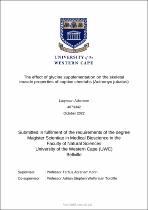| dc.contributor.advisor | Kohn, Tertius Abraham | |
| dc.contributor.author | Adamson, Luqmaan | |
| dc.date.accessioned | 2023-02-21T07:05:09Z | |
| dc.date.available | 2023-02-21T07:05:09Z | |
| dc.date.issued | 2022 | |
| dc.identifier.uri | http://hdl.handle.net/11394/9593 | |
| dc.description | >Magister Scientiae - MSc | en_US |
| dc.description.abstract | The fastest known land mammal – the cheetah, possesses many anatomical adaptations
that enables high-speed running. Current literature regarding the physiological aspects that
facilitate their incredible sprinting ability, however, remains limited. Although ensuring the
survival of the species, captive cheetahs experience several complications including reduced
fecundity and an increased incidence of degenerative disorders rarely observed in freeranging
cheetahs. A key difference in captive and free-ranging cheetahs is that their diets
differ substantially with regards to nutrient composition and availability, and previous studies
have highlighted the potential link between the diet of cheetahs and their overall poor
performance in captivity. | en_US |
| dc.language.iso | en | en_US |
| dc.publisher | University of the Western Cape | en_US |
| dc.subject | Diet | en_US |
| dc.subject | Nutrition | en_US |
| dc.subject | Glycogen | en_US |
| dc.subject | Bioscience | en_US |
| dc.subject | Animals | en_US |
| dc.subject | Land mamal | en_US |
| dc.title | The effect of glycine supplementation on the skeletal muscle properties of captive cheetahs (Acinonyx jubatus) | en_US |
| dc.rights.holder | University of the Western Cape | en_US |

